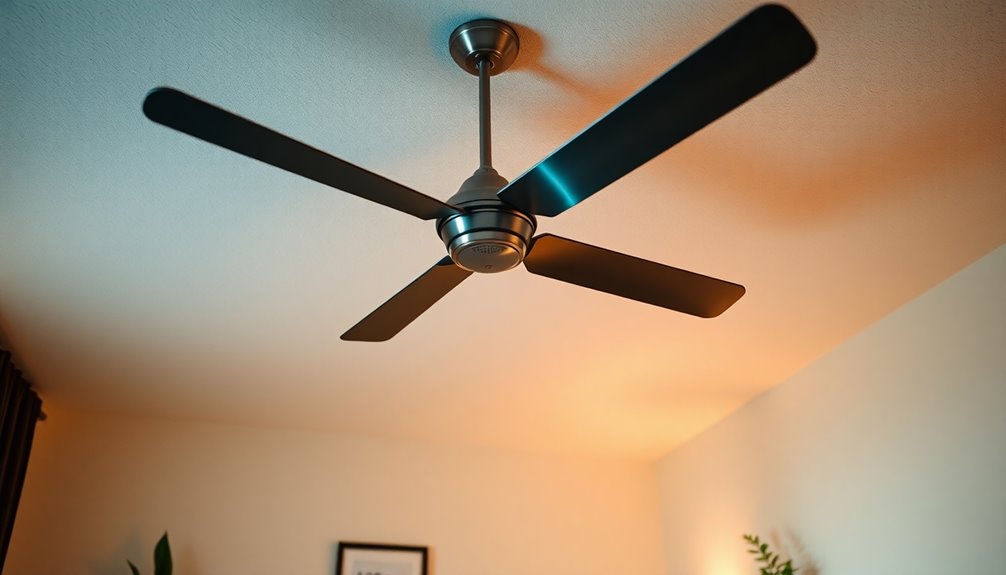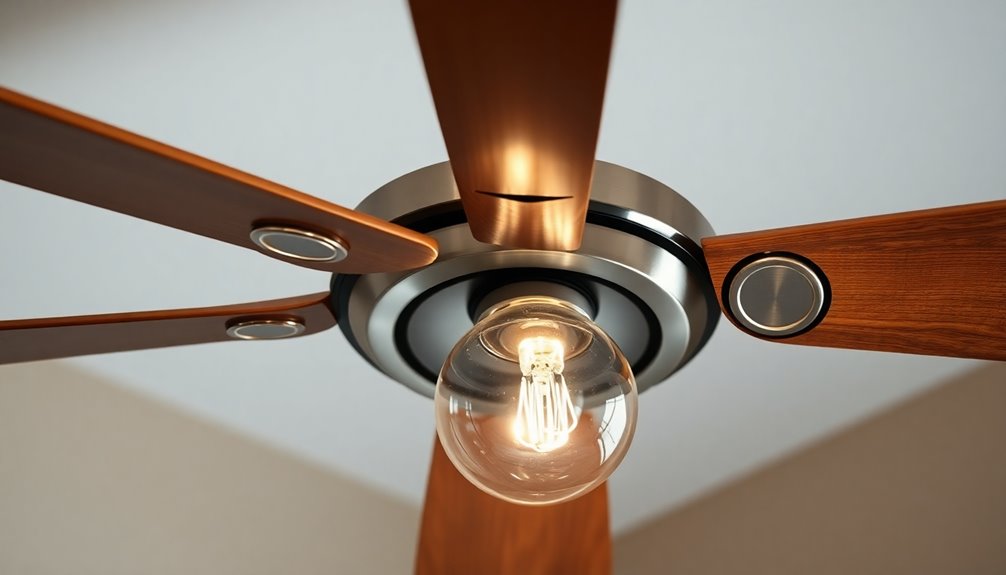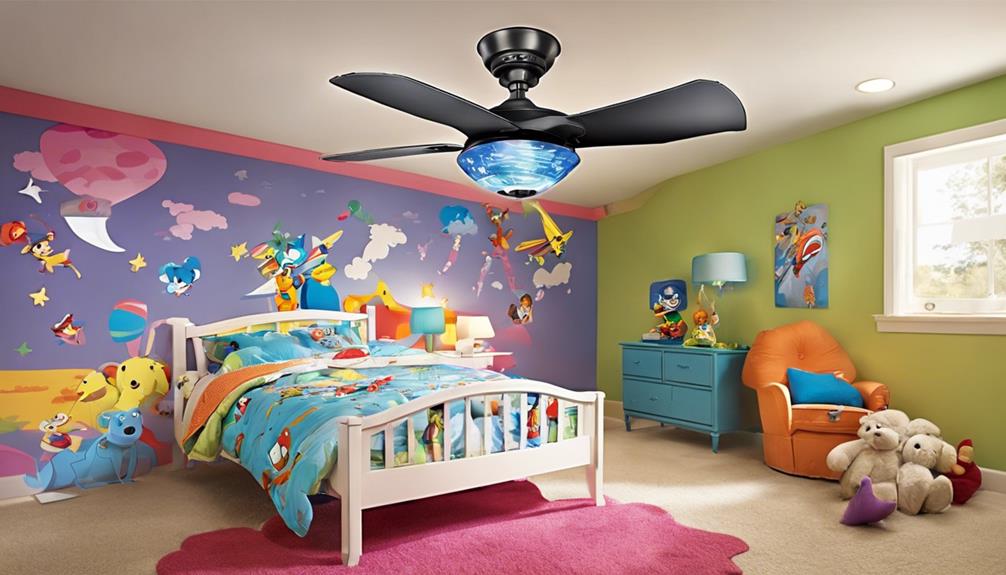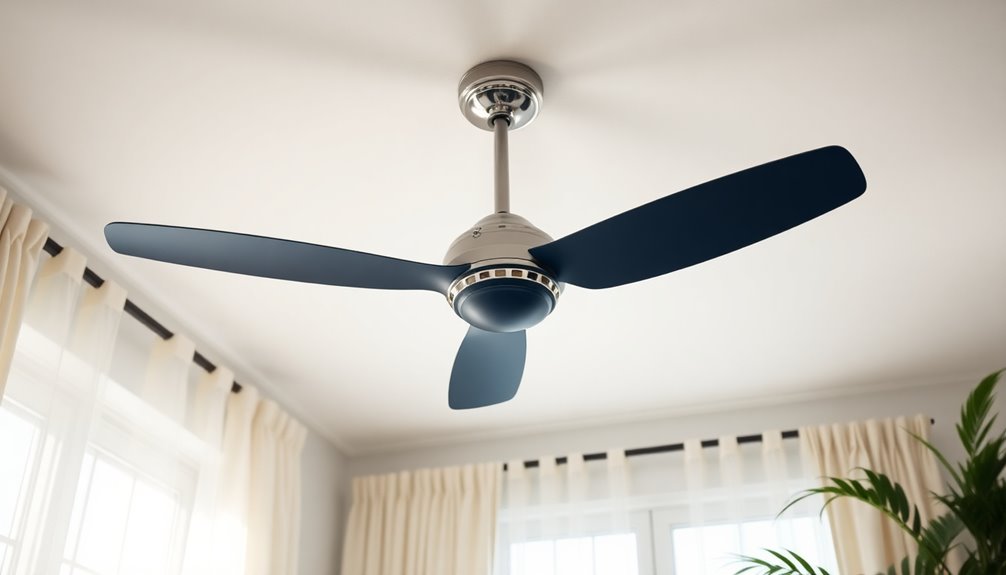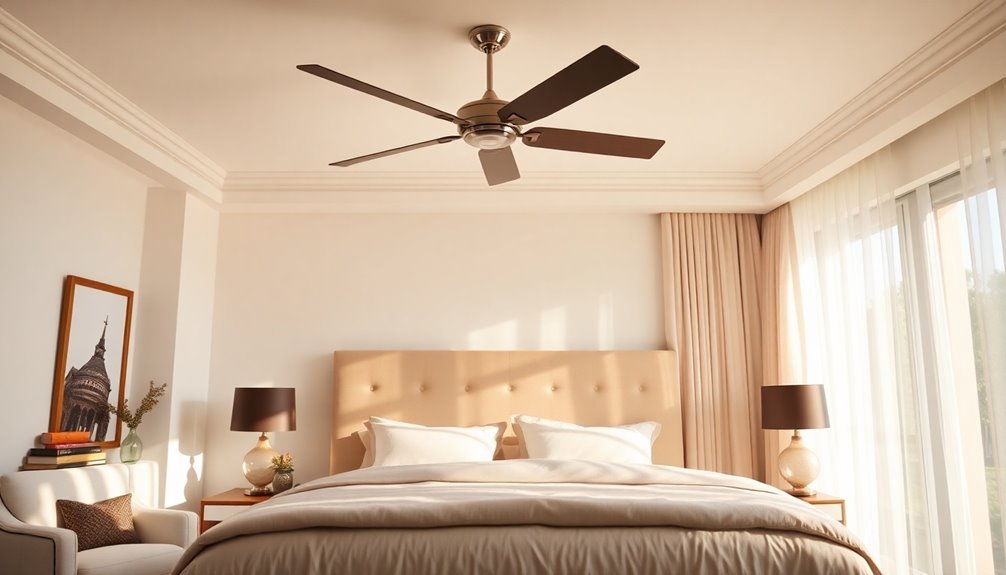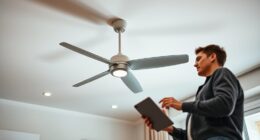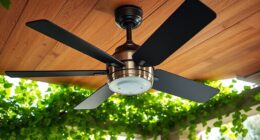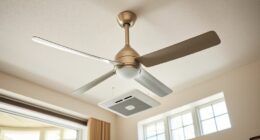A ceiling fan usually consumes between 0.05 and 0.1 kWh per hour. If you run a standard 75-watt ceiling fan for about six hours, you're looking at around 0.45 kWh for the day. Over a month, that adds up to roughly 13.5 kWh. This efficient usage keeps your energy costs low, often around $2.74 monthly based on average rates. If you're using an energy-efficient model, expect even lower consumption at just 15 to 25 watts. Want to know how to maximize your savings and comfort with ceiling fans? There's more to explore.
Key Takeaways
- Ceiling fans typically consume between 50 to 100 watts per hour, translating to 0.05 to 0.1 kWh usage.
- A 75-watt ceiling fan running for 6 hours uses approximately 0.45 kWh daily.
- Monthly usage for a fan running 6 hours daily averages around 13.5 kWh.
- Energy-efficient ceiling fans operate at only 15 to 25 watts, using 0.015 to 0.025 kWh.
- Daily operating costs for ceiling fans are generally around $0.05, depending on wattage and electricity rates.
Ceiling Fan Energy Overview

When it comes to energy consumption, ceiling fans are a smart choice for cooling your space. They typically operate at a ceiling fan wattage of 50 to 100 watts, translating to a mere 0.05 to 0.1 kilowatts per hour.
By running a 75-watt ceiling fan for just 6 hours daily, you'll use about 0.45 kWh of electricity. This minimal electricity usage means you'll only spend around $0.01 to $0.015 per hour, depending on your local electricity rates.
Over a month, using that fan for 6 hours each day adds up to approximately 13.5 kWh of energy consumption. This is a significant saving when you compare it to air conditioners, which can guzzle up to 3,500 watts or more per hour.
By opting for a ceiling fan, you're not just cooling your space; you're also making a choice to save energy and reduce your electricity bills.
Incorporating a ceiling fan into your cooling strategy can lead to substantial savings on your energy bill while keeping your environment comfortable.
Calculating Energy Usage

To calculate your ceiling fan's energy usage, you need to understand its power consumption basics.
Start by figuring out how many hours you run it daily, then you can estimate the costs based on your local electricity rates.
Knowing these details will help you manage your energy expenses more effectively.
Power Consumption Basics
Understanding how to calculate the energy usage of a ceiling fan can help you manage your electricity costs effectively. To start, you need to know the wattage of your ceiling fan, which typically ranges from 50 to 100 watts. You can calculate its energy usage by multiplying the wattage by the number of hours it operates each day.
Then, convert that figure into kilowatt-hours (kWh) by dividing by 1,000. For example, if you have a 75-watt ceiling fan running for 6 hours, it consumes 0.45 kWh. Here's how: 75 watts multiplied by 6 hours equals 450 watt-hours, and when you divide that by 1,000, you get 0.45 kWh.
If you operate that fan for an entire month, it would use approximately 13.5 kWh. To estimate the cost, multiply the kWh used by your local electricity rate, which averages about $0.10 per kWh in the U.S.
Daily Usage Calculation
Calculating daily energy usage for a ceiling fan is straightforward and can reveal significant insights into your energy consumption. To determine how much ceiling fan energy you're using, simply multiply the fan's wattage by the hours it operates each day, then convert that figure to kilowatt-hours (kWh) by dividing by 1,000.
Here's a quick reference table to help:
| Ceiling Fan Wattage | Hours Used per Day | Daily kWh Usage | Estimated Annual Cost |
|---|---|---|---|
| 50 watts | 6 | 0.3 kWh | $11.00 |
| 75 watts | 6 | 0.45 kWh | $16.50 |
| 100 watts | 6 | 0.6 kWh | $22.00 |
| 75 watts | 8 | 0.6 kWh | $22.00 |
For example, a 75-watt ceiling fan running for 8 hours a day consumes 0.6 kWh. Monitoring this daily usage helps you understand your electricity bill better, and tracking it over time can help you estimate your monthly and annual costs effectively.
Cost Estimation Methods
Estimating the cost of running a ceiling fan involves a simple yet effective method that can help you manage your electricity expenses.
First, you'll need to know the wattage of your ceiling fan. To calculate energy consumption, multiply the wattage by the number of hours the fan operates. Then, divide that number by 1,000 to convert it to kilowatt-hours (kWh). For instance, if you have a 75-watt ceiling fan running for 6 hours, you'd calculate 75 watts x 6 hours = 450 watt-hours, which equals 0.45 kWh.
Next, understanding your local electricity rate is essential. In the U.S., it's typically around $0.10 per kWh. So, if your fan operates for 8 hours a day, it would consume approximately 2.4 kWh per month, costing you about $0.24.
Cost of Operating Ceiling Fans

The cost of operating ceiling fans can be surprisingly low, making them an energy-efficient choice for keeping your home comfortable. A standard ceiling fan typically consumes between 50 to 80 watts per hour, translating to about 0.05 to 0.08 kilowatt-hours (kWh) of energy per hour of operation.
If you run your ceiling fan for 6 hours a day, you'll spend roughly $0.05 daily, which adds up to around $18.25 annually.
When you consider the average monthly cost of about $2.74, based on an electricity rate of $0.10 per kWh, ceiling fans become an attractive option for climate control.
If you opt for energy-efficient ceiling fans, you can lower your energy consumption even more, as these models use only 15 to 25 watts per hour.
Understanding your local electricity rate is essential since it directly impacts your overall operating cost. By knowing this, you can better estimate the annual cost of keeping your ceiling fan running.
Factors Affecting Energy Consumption

When considering the cost-effectiveness of ceiling fans, it's important to recognize the various factors that influence their energy consumption.
First, the wattage of your ceiling fan plays an essential role; fans typically range from 50 to 100 watts, with higher wattage fans consuming more electricity.
Next, think about the operational hours—running a 75-watt fan for 6 hours will consume about 0.45 kWh, so longer usage directly increases energy costs.
Energy efficiency varies based on the fan's design, including the number of blades and size.
Larger fans or those with more blades may be less efficient and use more energy. Additionally, the speed settings on your fan can alter its energy consumption; higher speeds usually mean higher wattage usage.
Finally, environmental factors like room size and airflow dynamics affect how efficiently your fan operates.
A well-placed fan can circulate air more effectively, reducing the need for higher speeds and ultimately leading to lower energy consumption.
Comparing Different Fan Types

In today's energy-conscious world, comparing different fan types can help you make informed choices about cooling your space efficiently.
Understanding the energy consumption of ceiling fans and other options allows you to select the best fit for your needs. Here's a quick comparison:
- Standard Ceiling Fans: Typically consume 50 to 100 watts, translating to 0.05 to 0.1 kWh per hour.
- Medium Ceiling Fans (48 inches): Use around 75 watts, which equals 0.075 kWh per hour.
- Large Ceiling Fans (52 inches): Can consume up to 90 watts, resulting in 0.09 kWh per hour.
- Energy-efficient Ceiling Fans: Operate as low as 15-25 watts, considerably reducing energy consumption to 0.015 to 0.025 kWh per hour.
When considering table fans, small models (4-6.9 inches) consume about 28.5 watts, equating to 0.0285 kWh per hour.
Larger table fans (10+ inches) use around 44.3 watts, or 0.0443 kWh per hour, making them a more energy-efficient choice for localized cooling.
Energy Efficiency Tips

Maximizing energy efficiency with your ceiling fan can lead to significant savings on your electricity bill. Start by choosing Energy Star-rated ceiling fans, which are 60% more efficient than non-rated models. This decision will dramatically reduce energy consumption and costs.
Make sure to turn off your ceiling fan when no one is in the room, as fans cool people rather than the air itself, saving you even more on your power consumption.
Selecting the right fan size for your space is essential. Larger fans may consume more power but can effectively cool larger areas, enhancing airflow and energy usage.
Additionally, consider adjusting your thermostat settings upward by 4°F while using a ceiling fan. This simple change can lower your air conditioning costs, as the fan enhances the perceived cooling effect.
Lastly, don't forget about regular maintenance and cleaning of your ceiling fans. Keeping them in good condition improves performance and efficiency, ensuring they operate at ideal wattage levels over time.
Benefits of Ceiling Fans

Ceiling fans offer a fantastic way to save on energy bills while keeping your home comfortable.
With their low wattage usage, they provide a cost-effective cooling solution that can help you stay cool without cranking up the air conditioning. Additionally, home security systems can help protect your space, giving you peace of mind while you enjoy the comfort of your ceiling fan.
Plus, the right fan can enhance your decor while ensuring your indoor environment feels invigorating. Additionally, using ceiling fans can complement heat pumps, which reduce energy bills by up to 50% when utilized together in a well-insulated home.
Energy Efficiency Advantages
Enjoying a more comfortable home while keeping energy costs down is one of the key benefits of using ceiling fans.
They're energy-efficient ceiling solutions that can greatly reduce your electricity consumption compared to traditional air conditioners. Using just 50 to 100 watts per hour, ceiling fans can save you money, costing around $18.25 annually if used for six hours a day.
Here are some energy efficiency advantages of ceiling fans:
- Energy Star-rated fans: These models are 60% more efficient than non-rated versions, ensuring better airflow with less energy.
- Reduced AC reliance: By raising your thermostat settings by 4°F while running a ceiling fan, you can lower air conditioning costs.
- Enhanced indoor comfort: Ceiling fans circulate air effectively, making your space feel cooler without cranking up the AC.
- Regular maintenance: Keeping your ceiling fan clean and well-maintained boosts its performance, leading to ideal energy savings.
Cost-Effective Cooling Solution
When it comes to staying cool during the warmer months, ceiling fans stand out as a cost-effective solution for enhancing indoor comfort. You'll find that ceiling fan uses are not only versatile but also economical. By running your ceiling fan for just six hours a day, you can keep your energy costs low—around five cents daily! This is a stark contrast to air conditioning, which can quickly drain your wallet.
Here's a quick look at the benefits of using ceiling fans:
| Benefit | Description |
|---|---|
| Energy Consumption | Ceiling fans average 75 watts per hour. |
| Daily Cost | Costs about $0.09 per day to operate. |
| Annual Savings | Approximately $32.85 annually for typical use. |
| Cooling Effect | Enhances comfort through airflow, not temperature. |
| Energy Star Efficiency | Up to 60% more efficient than non-rated fans. |
Enhanced Indoor Comfort
To boost your indoor comfort, ceiling fans are an excellent choice, as they create a revitalizing breeze that enhances the natural cooling effect of your body.
When you use a ceiling fan, you feel cooler even without lowering the room temperature. Here are some key benefits of using ceiling fans:
- Energy Efficiency: The average ceiling fan consumes about 75 watts per hour. When used for six hours, it costs roughly $0.09 per day. Additionally, many of today's ceiling fans are designed with energy-efficient models that help reduce electricity costs, similar to how HEPA filters contribute to cleaner air by using less energy.
- Temperature Flexibility: By pairing ceiling fans with your air conditioning, you can raise your thermostat settings by about 4°F, leading to significant energy savings.
- Improved Airflow: Energy Star-rated ceiling fans are designed to be 60% more efficient than non-rated models, providing greater airflow with less energy usage.
- Maintenance Matters: Regular cleaning and maintenance of your ceiling fan enhance its efficiency and effectiveness, ensuring peak indoor comfort and lower energy costs.
Additionally, using ceiling fans can help reduce air pollution by decreasing the reliance on energy-intensive cooling systems.
Frequently Asked Questions
How Much Does It Cost to Run a Ceiling Fan 24 Hours a Day?
Running a ceiling fan for 24 hours a day costs you about $0.18, given an average electricity rate of $0.10 per kWh.
If you keep it on every day for a month, you're looking at roughly $5.40.
This is a smart way to stay cool without breaking the bank, especially when compared to air conditioning costs.
Using a ceiling fan can really help lower your monthly energy bills during the hot months.
How Much Electricity Does a Ceiling Fan Use in 30 Days?
When it comes to saving energy, knowing how much electricity a ceiling fan uses over 30 days is key.
If you run a standard 75-watt fan for 12 hours daily, it'll consume about 27 kWh a month.
If you cut that down to 6 hours daily, it drops to around 13.5 kWh.
Does Running a Fan Use a Lot of Electricity?
Running a fan doesn't use a lot of electricity compared to other appliances.
In fact, ceiling fans typically consume between 50 to 100 watts per hour, which is quite efficient.
If you run one for about 6 hours a day, you'll only rack up about 5 cents in daily costs.
Does a Ceiling Fan Use More Electricity Than a Standing Fan?
Yes, a ceiling fan does use more electricity than a standing fan.
While ceiling fans typically consume between 50 to 100 watts, standing fans usually range from about 28.5 to 52.7 watts.
However, ceiling fans are designed to cool larger spaces more efficiently.
Conclusion
To sum up, ceiling fans are a smart energy choice, using just 10 to 120 watts per hour, depending on the model. That's way less than most air conditioners, which can use over 3,000 watts! By incorporating ceiling fans into your home, you can enjoy a comfortable environment while saving on energy bills. So, next time you feel a chill, remember that a ceiling fan might just be the efficient solution you need for a cool breeze!
